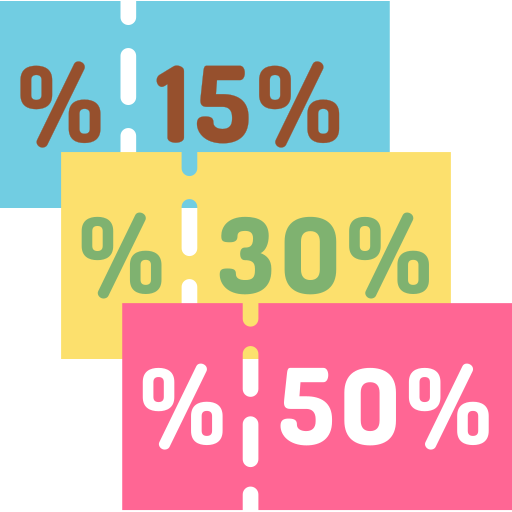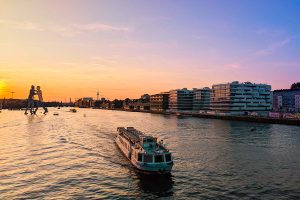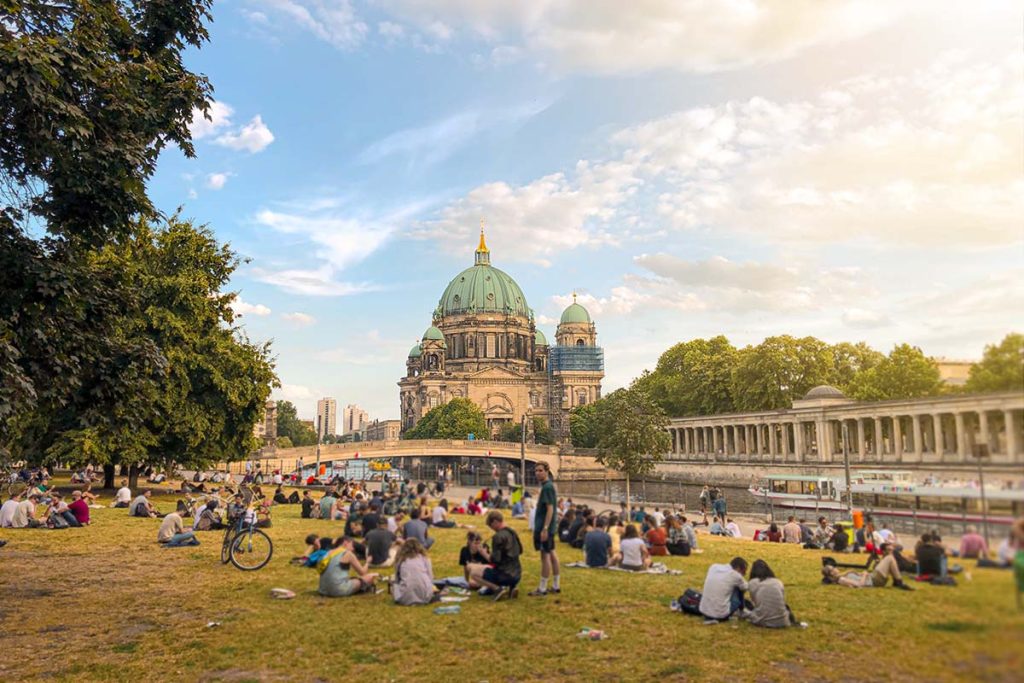
Locals share insider (and not-so-obvious) tips for traveling Berlin on a budget. From the best time to visit the city on the cheap, where to stay on a budget, the cheapest way to get around the city, to a list of free things to do, where to find cheap eats and more. This travel guide has it all!
Planning to visit Berlin and wondering whether it’s a cheap or expensive place to visit? We’re here to help! As expats who have lived here for 5 years (and counting), this is one of the most common questions we get.
The answer? It depends…
This is one of the reasons why we love the city. There’s something for everyone here. And yes – that also means that there’s something for every budget! Whether you want to bask in luxury or travel Berlin on a budget.
Traveling doesn’t have to be expensive, especially when you’re visiting the German capital.
We’ll show you exactly how to do that with our secret insider tips (and not-so-obvious ways) to save money traveling Berlin.
From the best time to visit Berlin on the cheap, where to stay on a budget, the cheapest way to get around the city, to a list of free things to do, where to find cheap eats, and more. This travel guide has it all!
Make sure you bookmark, share or pin this guide so you can refer back to it later.
Best Time To Visit Berlin On A Budget
One of the best ways to travel Berlin on a budget is to visit the city during off-peak or shoulder season. You’ll easily save 30% to 50% on flights and hotels just by avoiding the peak travel period.
When are those seasons exactly, you ask?
Peak season in Berlin is the summer vacation months between mid-June to end-August, as well as the Christmas market season from the last week of November to early January.
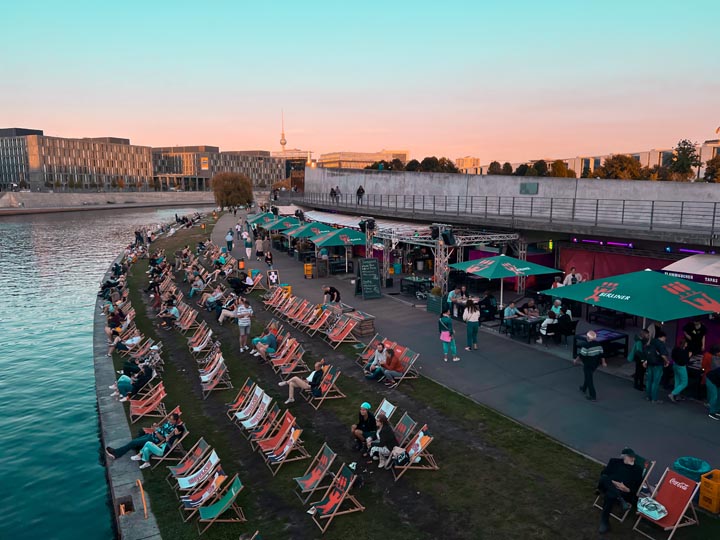
Shoulder season is the short periods just before and after that. That’s the months of May, September and early November.
January to April is the off-peak season when the city has the least tourists. This is THE best time to visit the city on a budget when hotel and flight prices are at their cheapest. But we do have to warn you – the weather will NOT be fun.
In addition to subzero temperatures, you can expect snow (if you’re lucky), gloomy skies, rainy weather, and short daylight hours. And if conditions are extreme, even black ice.
If the cold is an absolute no-go for you, then shoulder season is your next best bet. This is personally our favorite time to enjoy the city and what we call, the ‘Goldilocks’ season.
The weather is not too hot or too cold, there are not too many or too few travelers in the city, and finally, it’s not as expensive to visit.
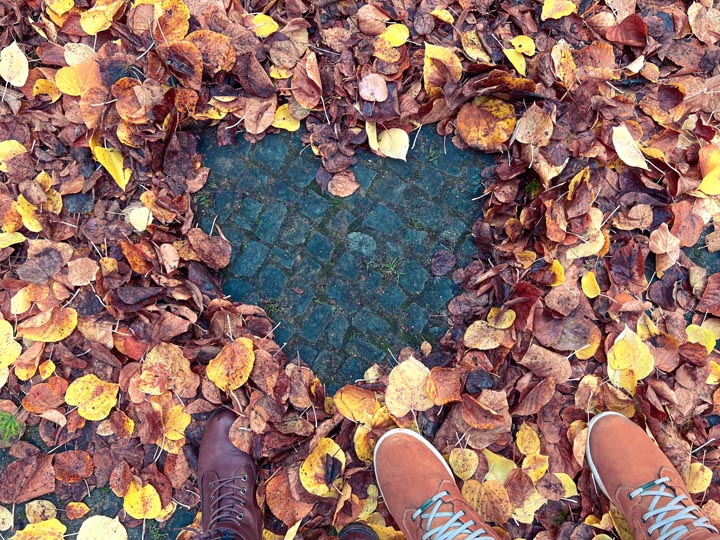
There is one thing you should watch out for though – annual events…
Berlin hosts many big events in the city like the Berlinale Film Festival (February), Christopher Street Day or Gay Pride (July), the Berlin Marathon (end-September), and the Festival of Lights (October), just to name a few.
And of course, in 2024 the city is hosting the highly anticipated UEFA Euro football games between 14 June to 14 July.
If you want to visit Berlin on the cheap, make sure to visit during off-peak or shoulder season AND avoid any big events.
Visit The City On Weekdays (Not Weekends)
We didn’t know this tip until we moved to Germany, but traveling on weekdays is WAY cheaper than weekends. Not only for flights and regional trains but hotel prices too!
This budget tip doesn’t just apply in Berlin, but for visiting any city in Europe.
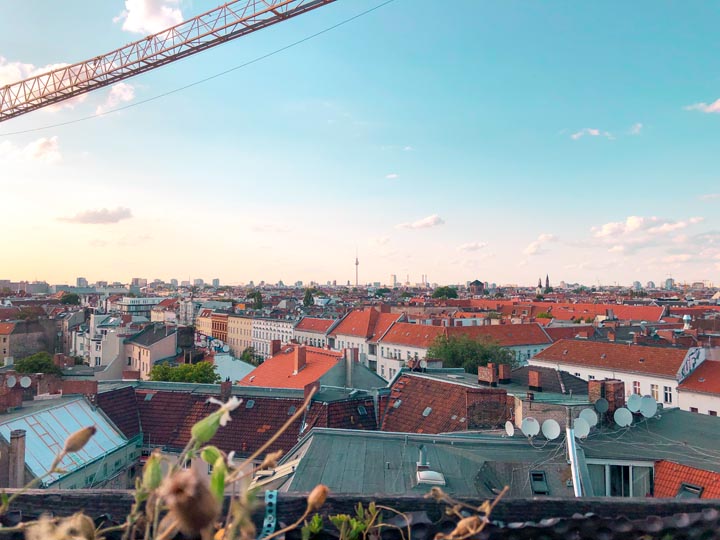
We’ve tested this in Amsterdam, Rotterdam, and Prague, and it was ALWAYS cheaper to visit between Monday to Thursday compared to Friday to Sunday.
The only exception to this rule – public holidays.
If possible, schedule your travel dates in Berlin for the weekday to reap some serious cash savings.
Best Places To Stay in Berlin On a Budget
Let’s start with where you should NOT stay in Berlin on a budget – the city centre, otherwise known as ‘Mitte’ (pronounced ‘mit-tah’ and means ‘middle’ in German).
Don’t get us wrong, Mitte is nice. It’s close to the most famous landmarks in the city. The location is central so you can easily get to other districts in less than 15 to 20 minutes. But the downside? It’s EXPENSIVE. Hotels cost an average of €150 to €300+ ($160 to $320) per night!
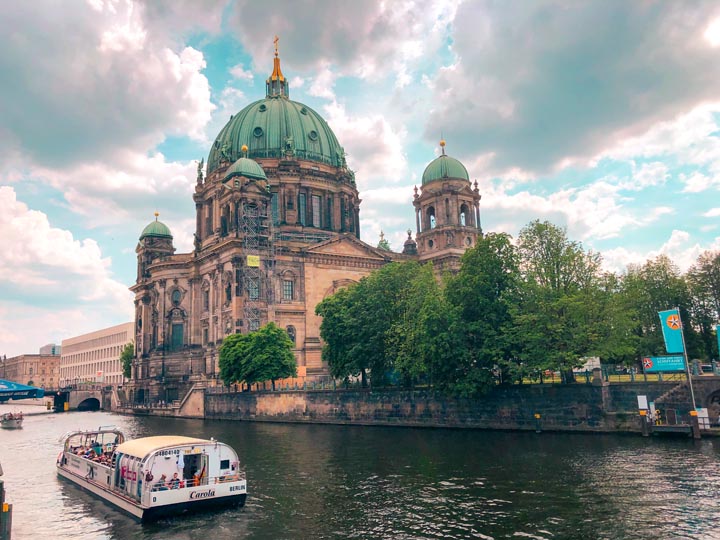
There are hostels in Berlin Mitte, of course. But there are more budget-friendly options beyond the city centre where you can stay for less than €20 ($21.50) per person sharing per night.
And the best part? These places are still located within the city’s zone A (i.e. central).
Here are some options:
- Grand Hostel Berlin Classic
- Grand Hostel Berlin Urban
- Generator Berlin Prenzlauerberg
- MEININGER Berlin Alexanderplatz
- Sunflower Hostel
- 36 Rooms Hostel Kreuzberg
Bonus Tip: Make sure you book your hotel early (2 to 3 months in advance) to get the cheapest prices. For more options, check out our Where To Stay in Berlin guide. We’ve shared the best neighborhoods to stay for nightlife, shopping, or a family vacation with kids, to the best areas to stay for Christmas markets, and events like the Berlin Marathon and UEFA EURO 2024 football tournament.
Cheapest Way To Get To Berlin
By Bus
There are so many ways to get to Berlin, but the cheapest (hands-down) is taking the bus. Companies like FlixBus offer ridiculously cheap bus tickets (as low as €5) if you book in advance.
Travel times may be a lot longer (depending on where you’re coming from), and it’s not the most comfortable way to travel. But for €5 – it’s totally worth it!
The next best budget option is to take the regional train or fly with a low-cost airline.
By Train
We love taking the regional train. It’s more eco-friendly, a great way to enjoy the country’s landscapes and most importantly, there’s no luggage limit. You can bring as much as you can carry.
We usually buy our train tickets from Deutsche Bahn (DB), the national railway company in Germany. You can get train tickets to Berlin not only from cities within Germany but also throughout Europe.
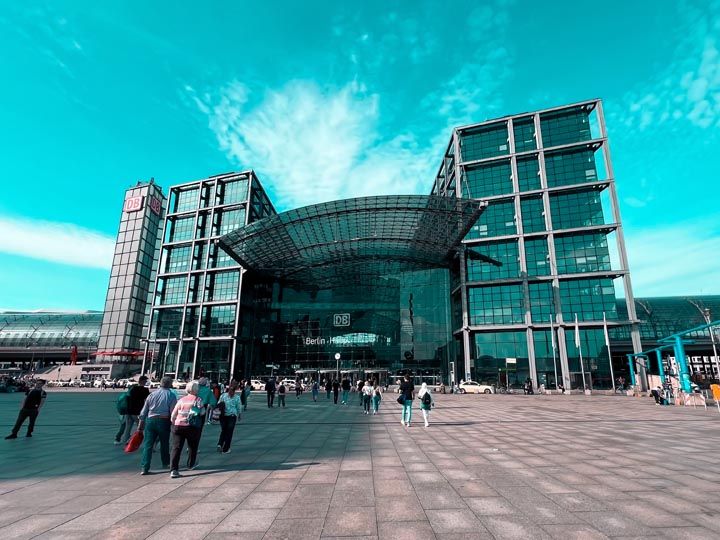
For the cheapest fares, make sure you book at least 60 days in advance (otherwise it becomes very expensive). Tickets are available from €17.90, and as low as €9.90 during promotional periods.
Flights
Flying with a low-cost airline like EasyJet or RyanAir is another budget-friendly way to get to Berlin. But you’ll only be able to take advantage of the cheap flights if you can travel light. By that, I mean traveling with a 7kg carry-on.
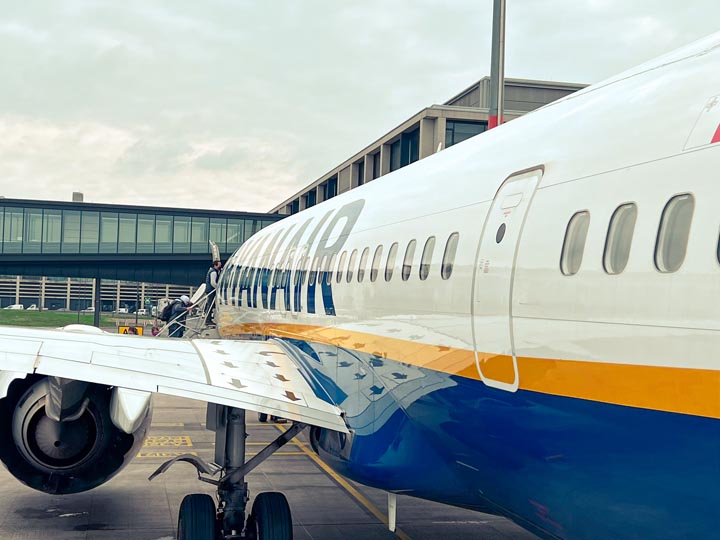
This is a hard one – we can never fit everything we need in a carry-on. But if you can (kudos to you), you can save up to 50% or more on flight tickets!
Bonus Tip: Easily compare prices for train and bus tickets to Berlin on the Omio app. Use our discount code – michas7p0y2t – to get €10 off your first booking.
Don’t Forget Travel Insurance
Travel insurance will protect you against injury, illness, theft and even trip cancellation. It’s comprehensive cover in case anything goes wrong. We never go on a trip without it as we’ve had to use it many times in the past. Here are our favourite companies that offer the best value and service:
- SafetyWing (best for everyone)
- AXA (for US residents)
- Outbacker (for UK residents)
- Allianz (for Germany residents)
Skip The Famous Red Hop On Hop Off Bus
Don’t get us wrong – the Berlin Hop On Hop Off Bus is a great way to see the city. We love the double-decker bus (especially when the weather is great) and the interesting things you learn about the city via the audio guide.
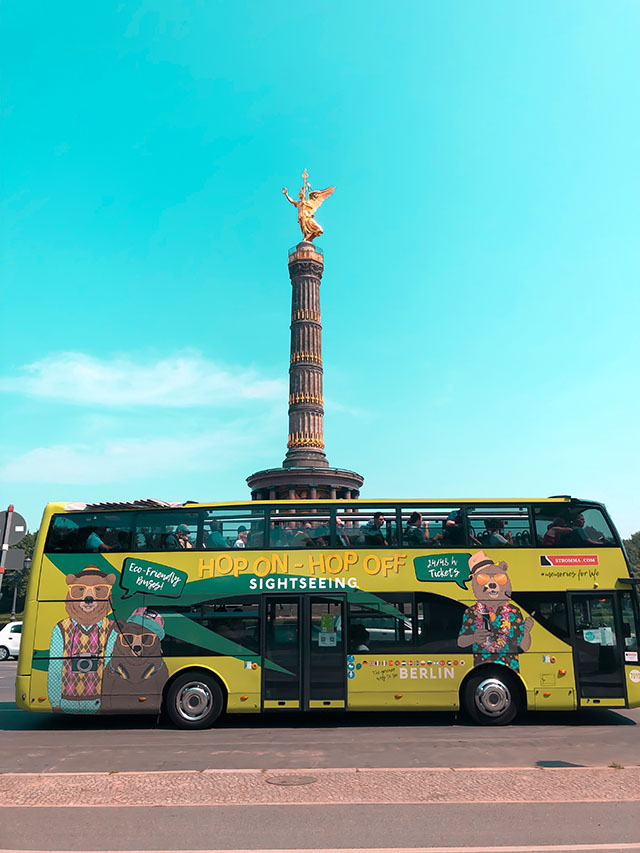
But if you want to explore the city on a budget, you can skip it and take the public bus (line 100) instead. All you need is a public transport ticket (more on this next).
Bus 100 starts at Zoologischer Garten and goes passed many of Berlin’s top attractions. This includes Kaiser Wilhelm Memorial Church, the Victory Column, Bellevue Palace, the Reichstag Parliament Building, Brandenburg Gate, Museum Island, and more!
Yes – there’s no audio guide and you won’t feel the wind in your hair. But you’ll still get to sightsee Berlin without killing your feet.
Bonus Tip: Need a place to store your luggage whilst you explore the city? Use Bounce to find a storage spot near you. I used this app for the first time in Venice and it was an absolute lifesaver! You can store your luggage for as little as €5 for the day and it’s totally safe. So much so, that Bounce offers insurance of up to $10,000 in the unlikely event your belongings are stolen, damaged or lost.
Take Public Transport
The cheapest way to get around Berlin is walking (obviously!). But it’s a pretty big city so unless you plan to only explore the neighborhood you’re staying in, you’re going to need some form of transport.
As locals, we always recommend taking BVG – the public transport system in Berlin. It’s fairly cheap compared to London or other European capitals with day tickets (24 hours) costing less than €10 ($11).
And yes – that means you can take as much public transport as you like (trains, buses, and trams) within a 24-hour window!
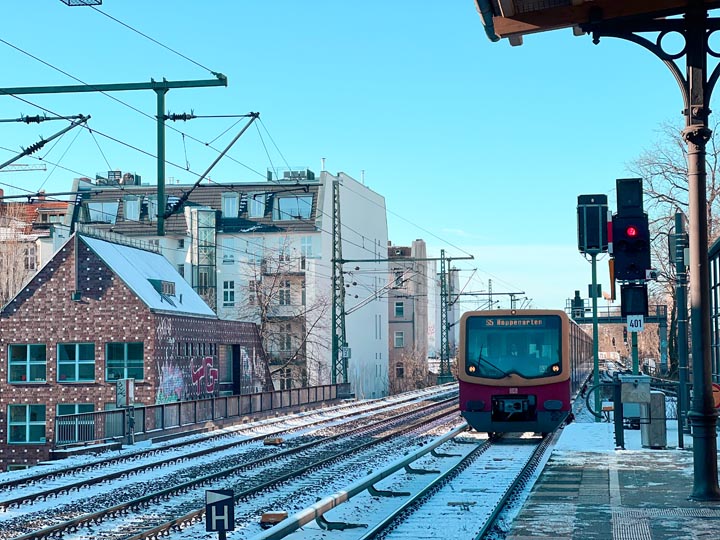
Taking public transportation is not only affordable, it’s convenient, eco-friendly, ‘weather-proof’ and easy to figure out. With the help of free apps like Google Maps or CityMapper, you’ll be able to get around Berlin like a local in no time.
For those of you who love to keep active whilst traveling, you could also get around the city by bike. Berlin is a very bike-friendly city – even for tourists! All you got to do is download an app to rent a bike.
It’s slightly more expensive than a public transport ticket but so much more FUN! Plus you get to see and experience the city in a completely different way.
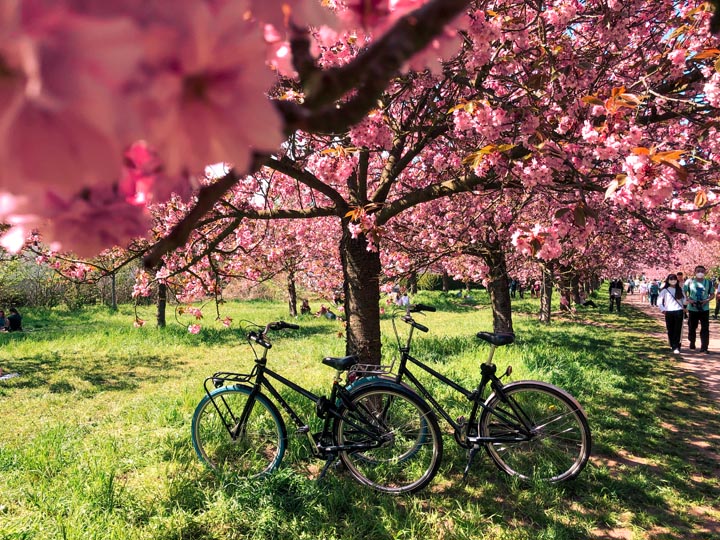
Ready to hop on that bike? Check out our Berlin Bike Sharing guide to find out how it works and which bicycle rental option is the cheapest for you.
Bonus Tip: Make sure you know these Cycling Rules in Germany before exploring Berlin by bike.
Is The Berlin Welcome Card Worth It?
If you’re traveling with kids, then YES – it’s absolutely worth it (i.e. cheaper)! With the Berlin Welcome Card, kids under the age of 14 get to take public transport for free with an accompanying adult. That’s an immediate saving of €6.50 per day per kid!
If you’re not traveling with kids – the answer depends on how many days you’re spending in the city and whether you’re visiting attractions or not.
We’ve done the maths so you don’t have to.
| Number of Days | Public Transport (BVG) | Berlin Welcome Card | Price Difference |
|---|---|---|---|
| 2 Day Ticket | €19.80 | €26.00 | -€6.20 |
| 3 Day Ticket | €29.70 | €36.00 | -€6.30 |
| 4 Day Ticket | €39.60 | €45.00 | -€5.40 |
| 5 Day Ticket | €49.50 | €49.00 | €0.50 |
| 6 Day Ticket | €59.40 | €54.00 | €5.40 |
If you’re spending 2 to 4 days in Berlin, the Welcome Card (for AB zone) is only worth it if you’re going to visit 3 or more attractions (where you get up to 50% off). If not, then it works out cheaper to just buy a public transport ticket for 2, 3 or 4 days.
However, if you’re spending 5 or 6 days in Berlin, then the Welcome Card is oh so worth it! It actually works out cheaper than buying a public transport ticket for those number of days even if you don’t visit a single attraction…
Still unsure? Check out the full list of discounts you’ll get with the Welcome Card before deciding. Otherwise, just download the BVG app and purchase your tickets directly on your phone.
Skip Breakfast
Don’t get me wrong – I’m totally a breakfast person. In fact, I’m the wake-up-where’s-my-food-at type.
But skipping the hotel breakfast (if it’s not included with the room) will save you at least €20 ($21.50) per person per day. Instead, head to a local bakery for breakfast at a fraction of the price.
Berlin has plenty of great cafes and bakeries. And, of course, German bread is LEGENDARY!

Go To The Supermarket
Grabbing small meals and snacks from the supermarket instead of eating out 3 times a day, is a super easy way to travel Berlin on a budget.
Groceries in Germany are notoriously affordable! So much so, that it’s even cheaper than neighboring countries like Austria, the Czech Republic, and even Greece and Croatia!
The cheapest grocery stores are Lidl, Aldi, Penny and Netto. But they don’t have a big variety of prepared meals. If you’re looking for ready-to-eat sandwiches, salads, soups, or even sushi, you’ll have better luck finding them at mid-range supermarkets like Rewe, Edeka and Kaufland.
Oh, and while you’re at it. You might as well grab a few beers or mini wines for the road. It’s legal to drink in public in Germany.
Alternatively, you can grab a drink from a späti (what locals lovingly call late night shops or kiosks). It’s more expensive compared to the supermarket, but WAY cheaper compared to drinking at a bar, pub or beer garden. Plus, you’ll get a more local Berlin experience.
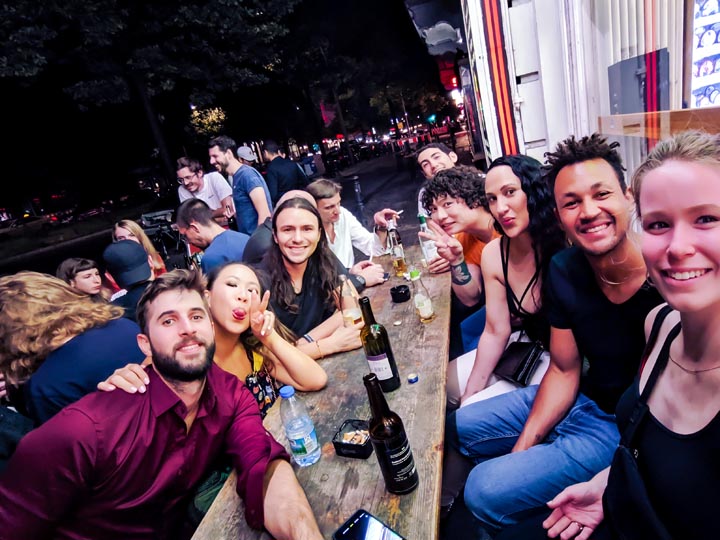
Eating Out
You’ll never run out of options to eat out in Berlin. The city offers a wide variety of cuisines at different price points.
An average meal at a sit-down restaurant will cost you between €15 to €25 per person (excluding drinks). But there are also cheap eats that you can enjoy for less than €10 per person.
These places are more take-out and casual dining spots than restaurants. However, the food is just as tasty (if not better).
Some of our favorite cheap eats in Berlin are:
- Hamy Cafe Foodstore (for Thai and Vietnamese fusion food)
- Curry36 (for Berlin’s famous curry sausage – ‘currywurst’)
- Ruyim Doner Kebab (try with all sauces)
- Burger Meister (for mouth-watering burgers)
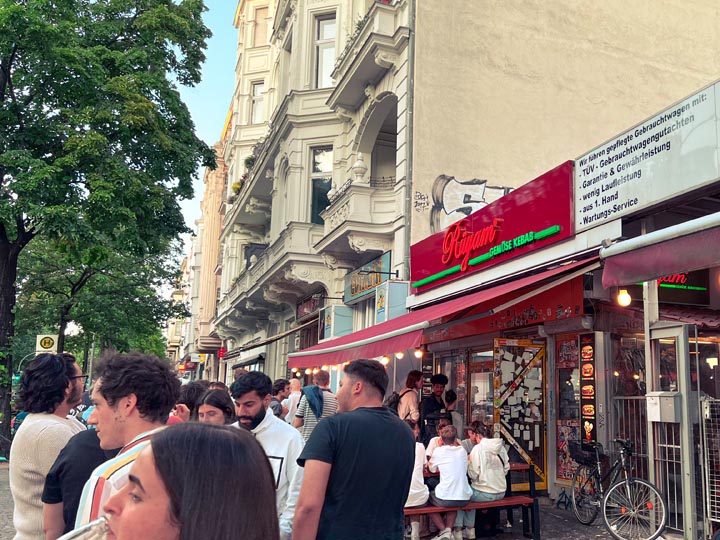
Bonus Tip: For more budget places to eat, use Google Maps. Select restaurants then price and click on the single Euro (€) option. This will filter all the budget-friendly places to eat in Berlin.
Explore Free Things to Do in Berlin
This tip surprises many tourists. But there are in fact so many free things to do in Berlin, that you could easily spend a weekend here without spending a cent.
Here are some examples of free attractions you can visit (not an exhaustive list by any means):
- Seeing the famous Brandenburg Gate (or ‘Brandenburger Tor’)
- Admiring the Victory Column at Grosser Stern
- Checking out the 100+ murals at East Side Gallery
- The Berlin TV Tower (you only pay if you want to go to the top)
- Visiting the Berlin Wall Memorial at Bernauer Street
- The Holocaust Memorial (please be respectful when taking photos)
- Exploring Checkpoint Charlie
- Walking around the beautiful gardens of Charlottenburg Palace
- Checking out thought-provoking street art in Kreuzberg and Friedrichshain
- Going inside the Reichstag Dome (it’s free but you need to reserve a spot in advance)
- Watching the famous Berlin Philharmonie Orchestra perform (every Wednesday 13:00)
- Visiting the Sachsenhausen Concentration Camp (free but in our opinion, best to go with a guide)
- Admire palaces and castles in Potsdam (the largest UNESCO World Heritage Site in Germany)
- Wandering around the vibey flea markets of Berlin (Mauerpark and RAW Flohmarkt on Sundays)
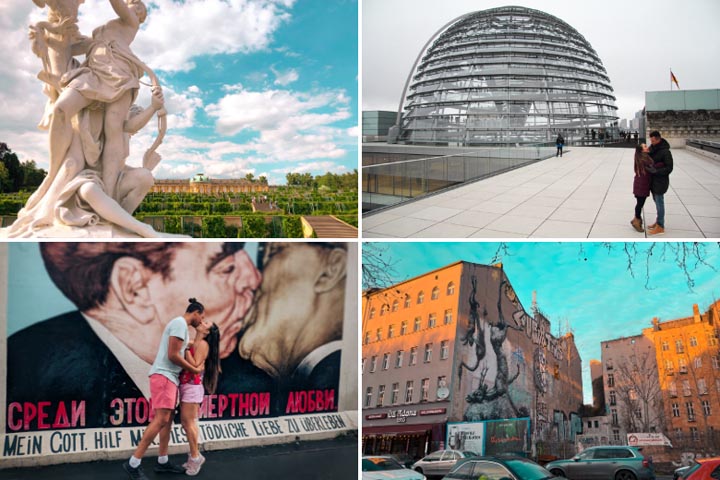
Bonus Tip: Follow our free self-guided Berlin Wall Bike Tour and see most of the city’s famous attractions in 1 or 2 days.
That’s not all! You can also visit certain museums in Berlin for FREE! Again, not an exhaustive list:
- Urban Nation (for contemporary art)
- Futurium (the museum of the future)
- The Topography of Terror (book the free guided tour – it’s fascinating)
- Famous Museums on Museum Island (only on the first Sundays of every month)
Related Guide: Looking for free things to do in Berlin when it’s cold or rainy? Check out our Berlin 3 Day Winter Itinerary for more ideas.
Bring A Water Bottle
Another not-so-obvious but easy way to save money traveling Berlin is to bring a water bottle with you.
A lot of restaurants, cafes and bars here will refuse to serve you tap water. You’ll have to order bottled water. And the few that do will charge you for it (without telling you).
A friend of ours was once charged €3 for a glass of tap water at a restaurant. And let me tell you, it doesn’t leave a good taste in your mouth (pun intended) when you could have paid an extra Euro or two for bottled water instead…
No wonder people say drinking beer is cheaper than water in Germany… It’s true – but only when you’re dining out. If you buy water from the supermarket, water is definitely cheaper than beer.
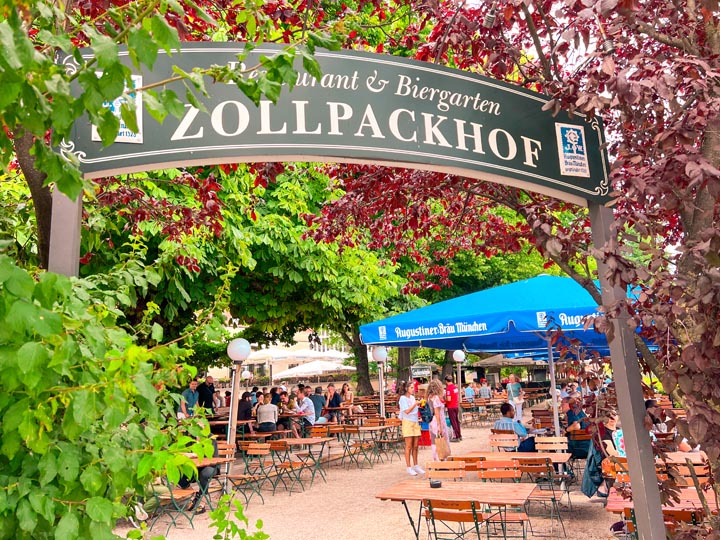
But why pay anything at all when it’s perfectly safe to drink tap water in Germany? Maybe it’s not the best-tasting water, but it’s also not the worst that we’ve tasted either.
Save yourself the money and most importantly, save the planet by reducing plastic waste and drink tap water instead.
Berlin has over 200 public water fountains where you can get free drinking water. Here’s the map to find them. Make sure you allow cookies to use their interactive map.
Have Cash Money
Berlin is many things, but card-friendly… isn’t one of them. You’ll be surprised by the number of restaurants, bars and cafes that accept cash only.
This is slowly (very slowly) changing. But in the meantime, just assume that most places accept cash only. You can also just ask beforehand if you prefer to pay by card.
All supermarkets and major food franchises (i.e. Starbucks) accept card payments though. VISA and Mastercard are the most widely accepted. American Express? Not so much (besides at the grocery stores)…
This leads us to our next point.
Save Me For Later
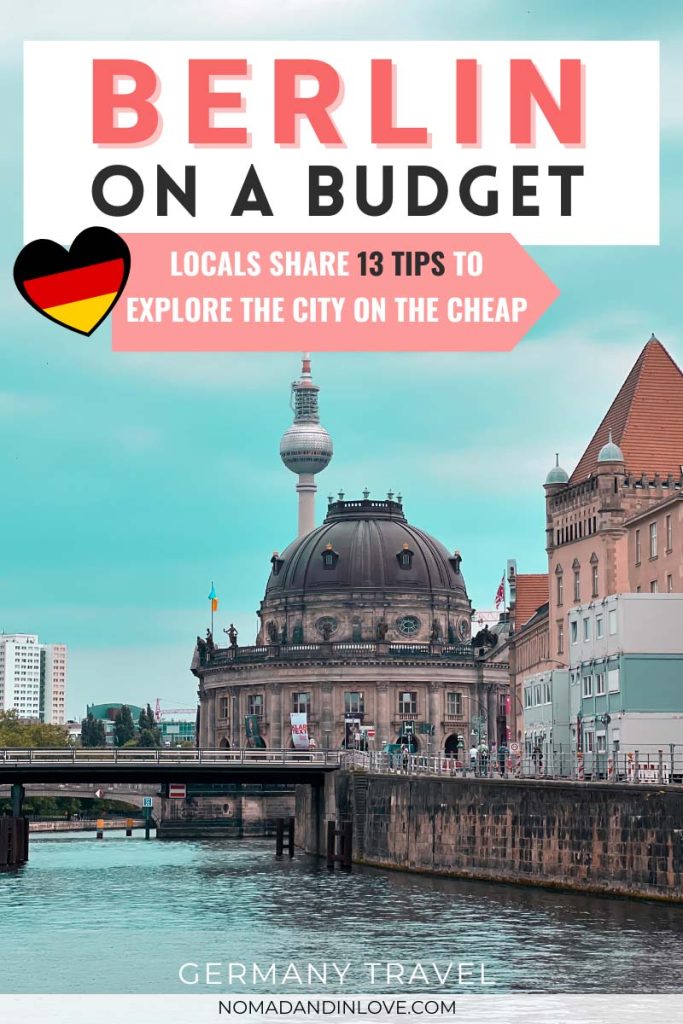
Where To Withdraw Cash For Free in Berlin?
Good question! This depends on the bank card you use.
If you’re using Revolut or Wise bank cards like us, you can draw at any major German bank without fees as long as it’s within your free monthly withdrawal limits.
Just head over to a Deutsche Bank, Post Bank, Berliner Volksbank, or Sparkasse ATM to withdraw and get cash without paying any fees.
Whatever you do, DO NOT draw at a Euronet (or EC) ATM unless you have a German bank card that allows you to withdraw cash with them for free. These EC ATMs are super easy to find since they’re literally everywhere. But they will charge you a whopping €5 per transaction.
Trust us, we experienced that firsthand and we’re never making that mistake again.
Bonus Tip: Make sure you’ve already converted your money into Euros before withdrawing so you don’t end up paying exchange rate fees.
Get a Local SIM card
This is a universal budget tip (not just for Berlin). Always get a local SIM card. Never – I repeat – NEVER use international roaming.
Not only will you save yourself A LOT of money, but also the anxiety of waiting for that dreaded phone bill…
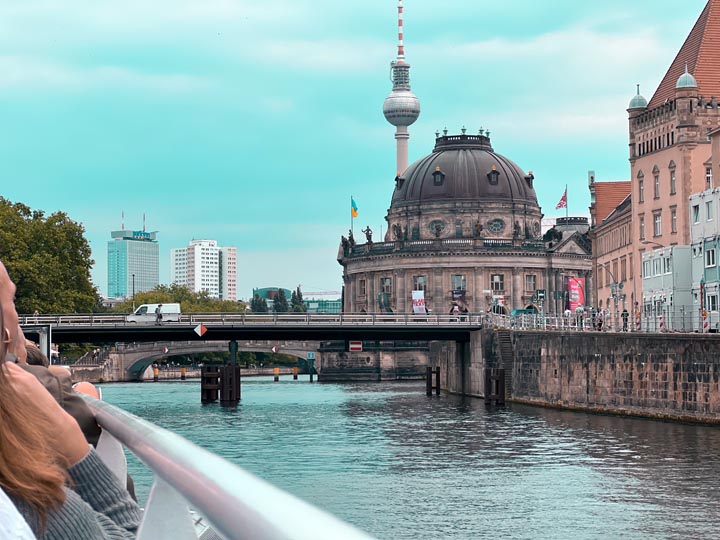
You can easily buy a prepaid SIM card at any local supermarket in Berlin. They’re available at the airport too, but it’s usually more expensive.
For the ultimate convenience, we’d recommend getting an eSIM. That way you’re able to hop online as soon as the seatbelt signs are turned off and you don’t have to waste any time hunting down a SIM card.
We always opt for eSIMs when we travel. We love the ease that everything is done online and that you’re able to top up if needed. Plus, it’s eco-friendly since you’re not creating any waste. A win-win all around!
Wrapping Things Up
Whether you’re a solo traveler backpacking Berlin or traveling as a family with kids, it’s easy to explore the city on a budget.
The easiest way to save money on the trip is to visit during off-peak season. You’ll get the cheapest prices for flights, regional trains, and hotels simply by scheduling your travel between January to April when the city has the least tourists.
The best place to stay in Berlin on a budget is any neighborhood besides Mitte (the city centre). Hotels and accommodation are generally more expensive there.
Just these 2 tips alone will save you a ton of money exploring the city. But you could also combine it with our other tips like taking public transport, skipping the hotel breakfast, and opting for free things to do to REALLY explore and travel Berlin on the cheap.
We hope our local insider tips have helped save you time, money, and stress planning your vacation in Berlin. As always, feel free to send us a message on social media or e-mail if you have any questions.

